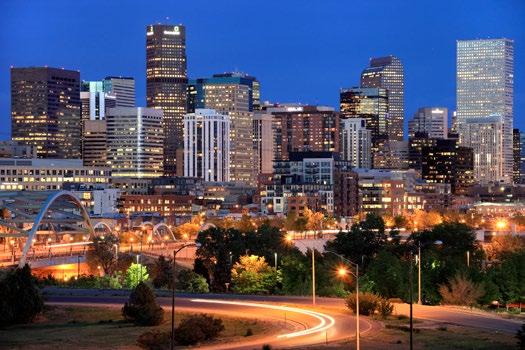
2 minute read
HOT NEIGHBORHOODS FOR MULTIFAMILY
Demand in Denver
Denver’s multifamily market quickly rebounded from the temporary pandemic-related dips in rent and leasing growth, bouncing past pre-2020 levels and resulting in a crowd of developers eager to capitalize on sustained demand. Despite some recent cooling — concerns over inflation and a significant influx of new construction projects have weighed on rent growth in recent months — annual rent growth is still about 3% above the year-earlier period and is even higher in some of the city’s fastest growing neighborhoods.
Advertisement
The West Denver area, for example, is home to some of the region’s trendiest residential pockets, according to CoStar analysis. Renters have been drawn to neighborhoods there for the easy access to light rail and a plethora of retail options, and developers have been quick to snap up sites to accommodate rising demand for housing.
Denver’s multifamily construction pipeline is slated for another burst of action to cap a record year as developers from across the country look to the Mile High City for the ongoing demand that’s fueling rent growth.
Captivating Colorado Springs
Record rent growth in one of Colorado’s largest mountain cities has prompted an out-of-state investor to cash out more than three years earlier than it expected. Located about an hour south of Denver, the multifamily market in Colorado Springs has benefited from its proximity to major employers, including Lockheed Martin, United Health Group, Progressive Insurance, Oracle, T. Rowe Price Group and USAA. Population growth has triggered a nearly 47% spike in apartment construction in the city, according to CoStar data. Even so, housing demand continues to outweigh available supply.
Rents in Colorado Springs have climbed by almost 6% in 2022, according to CoStar data, settling at an average of nearly $1,300 per month.
published on January 9, 2023
Accelerating in Aurora
Renters have flocked to Aurora — Colorado’s thirdlargest city — for the past decade, fueling record rent growth as high as 14% in 2022, according to CoStar data.

As a result, developers have been quick to break ground on new projects in the area to capitalize on accelerating demand. More than 3,100 units have been added to the region’s inventory over the past five years, dwarfing the 1,200 units that were completed between 2010 and 2017. What’s more, another 1,500plus units are moving through the construction pipeline, set to expand Aurora’s inventory by roughly 4%, according to CoStar data.
Thriving in Thornton
Located about 10 miles north of downtown Denver, Thornton has become a multifamily hot spot in recent years as renters descended on the area in search of affordable housing options and a seamless commute. The region has been one of Denver’s best rent growth submarkets through the pandemic, according to CoStar data, with annual rent growth as high as roughly 15% in early 2022.
Thornton renters now pay an average of $1,685 per month, according to CoStar data, about 2.5% higher compared to this time last year (2022).
Prospering in Parker
With its proximity to a mix of recreational amenities and a number of transit hubs, the Parker area has grown in recent years thanks to an influx of emptynesters and office workers looking for an easy commute. Companies including Kaiser Permanente and Charles Schwab have recently expanded their presence in the area, helping to boost annual rent growth to nearly 9.5% at the end of the second quarter in 2022, according to CoStar data.
Rents in the Parker area also surpass those reported across greater Denver, averaging about $2,000 per month compared to the metropolitan average of roughly $1,770 a month. The ongoing population and employment growth has also resulted in a 60% boost to apartment rents over the past decade, according to CoStar data.
(Initially published on November 17, 2022 - Denver’s Multifamily Market Lands Another Big-Name Developer Chasing Rising Demand)




